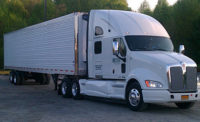Cutting a few dollars from the transportation budget isn’t always the smartest choice—especially for refrigerated and frozen foods. A mismanaged cold chain can quickly have serious quality and safety concerns that cost more than any transportation savings. Focusing on the right technology and knowledge rather than price not only helps mitigate risks, but it also can impact the bottom line.
More than track-and-trace technology
A large part of keeping foods refrigerated or frozen while in transit is the technology that monitors temperature. Today’s technology is rapidly expanding beyond basic track-and-trace capabilities. It’s now possible to use time-temperature recorders, temperature sensors and GPS technology to gather data and send alerts if temperatures move outside a specified range—even during loading, unloading and delivery.
If a carrier hauling berries from California to New Jersey receives an alert that the trailer temperature is slowly falling, the provider and customer can be immediately informed. Together, the parties involved can make a decision and take immediate action to address the situation—whether that’s to repair the trailer or move the product to a new, working trailer. This situation, while not ideal, is preferable to opening the trailer at the final destination and being surprised to find the majority of the berries spoiled in transit.
Is the latest technology worth the cost?
More advanced technology can provide access to a very broad spectrum of information. Access to this information often comes with an additional pricetag. Determining if real-time temperature sensor alerts makes sense is a balancing act between product quality and profits. Maintaining proper temperature ranges are needed to ensure the highest possible quality product upon delivery. Yet overpaying for transportation may cut into profits.
For less sensitive commodities, paying for high levels of technology and access to information may not be necessary and therefore add unnecessary expenses into the supply chain. On the other hand, delicate, sensitive and high-value foods can support the additional expense of real-time monitoring and still maintain profit levels through reduction in shrink and faster turns. The right experts can help find the right balance between cost and information.
Bring in the refrigerated and frozen experts
The right provider will have access to all the latest technology options to help guide your cold chain efficiency and support your business. They should also be able to take it a step further too—they’ll have expertise on their side. While technology plays a huge role in keeping refrigerated and frozen foods safe, nothing can replace the knowledge and skill behind the decision process.
Proficiency is more than just having a number of people available to do the job. It’s truly about understanding and executing. A qualified expert will understand how important it is to maintain a strong relationship with all involved parties—carriers, shippers, suppliers and receivers. They’ll also know how to solve problems quickly and efficiently.
Applying expertise to capacity
Refrigerated transportation knowledge even extends to procuring capacity. A true specialist will be able to balance unattractive load qualities with more strategic initiatives to build relationships between the carrier and shipper by providing benefits to both parties.
Choosing a provider
Depending on the organization, an internal refrigerated expert can suffice. However, always ask these five questions before choosing a cold chain transportation provider:
1. What experience will the provider bring that adds value? Consider the provider’s reputation in the industry along with the specific tools, resources and capabilities they offer. Ultimately, a provider’s abilities should align with long-term goals.
2. What technology options do they offer? A provider should have the ability to align appropriate technology with the appropriate need, both today and into the future.
3. How does the provider handle surges in demand? A well-developed network and consistent procedures can secure capacity space even during times of high demand. This can mean the difference between quality and spoiled foods.
4. Can the provider stand behind their financial commitment? Financial stability can be as tactical as standing behind a claim or as strategic as offering long-term investment strategy and multi-year pricing disciplines.
5. How does the provider react to obstacles? Communication is key when things go wrong in a supply chain. Having a standard process to handle returns, claims, rejections and damages often indicates the provider is adept and skilled at resolving issues. A solid provider will not only have a process in place to re-power or relay a load while in transit, but they’ll also communicate any problems that do arise.
Finding a balance without sacrifice
Maintaining customer satisfaction when delivering refrigerated and frozen foods in today’s world is a complex situation. Transportation is a significant contributor to achieving a successful customer experience. Cutting transportation costs will likely sacrifice either technology or expertise, which will only lead to more costly problems. Instead, strategic decisions that balance transportation technology, know-how and cost are a far superior way to reach long-term goals.



